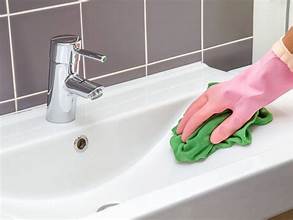Before diving into the Washroom Sink Cleaning process, it’s essential to understand the material of your washroom sink. Different materials require specific Washroom Sink Cleaning methods to avoid damage. Common sink materials include:
- Porcelain: Porcelain sinks are durable and resistant to stains, but they can be prone to scratches if abrasive cleaners are used.
- Stainless Steel: Stainless steel sinks are resilient and easy to clean, but they can show water spots and fingerprints if not properly maintained.
- Ceramic: Ceramic sinks are similar to porcelain and are known for their durability and resistance to stains.
- Stone: Stone sinks, such as granite or marble, require special care to prevent scratching and etching.
Now that you’ve identified the material of your sink, let’s explore the step-by-step process for achieving a sparkling clean finish.
Step 1: Gather Your Supplies
Before you begin cleaning, gather the necessary supplies:
- White vinegar
- Baking soda
- Dish soap
- Lemon
- Microfiber cloth or sponge
- Old toothbrush
- Rubber gloves
- Spray bottle
Step 2: Clear the Surface
Start by removing any items from the sink, such as toothbrushes, soap dishes, or makeup containers. Dispose of any debris or hair in the trash to prevent it from clogging the drain.
Step 3: Create a Cleaning Solution
For a natural and effective cleaning solution, mix equal parts white vinegar and water in a spray bottle. Alternatively, you can create a paste using baking soda and water for tougher stains.
Step 4: Apply the Cleaning Solution
Spray the cleaning solution generously onto the surface of the sink, ensuring full coverage. For stubborn stains or hard water deposits, apply the baking soda paste directly to the affected areas and let it sit for a few minutes.
Step 5: Scrub Thoroughly
Using a microfiber cloth or sponge, scrub the sink surface in circular motions, focusing on areas with visible stains or buildup. For hard-to-reach areas, such as around the faucet or drain, use an old toothbrush to scrub away dirt and grime.
Step 6: Rinse and Dry
Once you’ve scrubbed the entire sink, rinse the surface thoroughly with warm water to remove any remaining cleaning solution or residue. Use a clean cloth to dry the sink, ensuring a streak-free finish.
Step 7: Maintain Regular Cleaning Habits
To keep your washroom sink looking its best, establish a regular Washroom Sink Cleaning routine. Wipe down the surface after each use to prevent soap scum and toothpaste residue from accumulating. Additionally, consider using a sink strainer to catch debris and prevent clogs in the drain.
Conclusion:
A clean washroom sink not only enhances the overall appearance of your bathroom but also promotes hygiene and cleanliness. By following these simple yet effective cleaning techniques, you can maintain a sparkling clean sink for years to come. Whether you have a porcelain, stainless steel, ceramic, or stone sink, regular maintenance and gentle Washroom Sink Cleaning will ensure that your washroom remains a sanctuary of cleanliness and tranquility.
